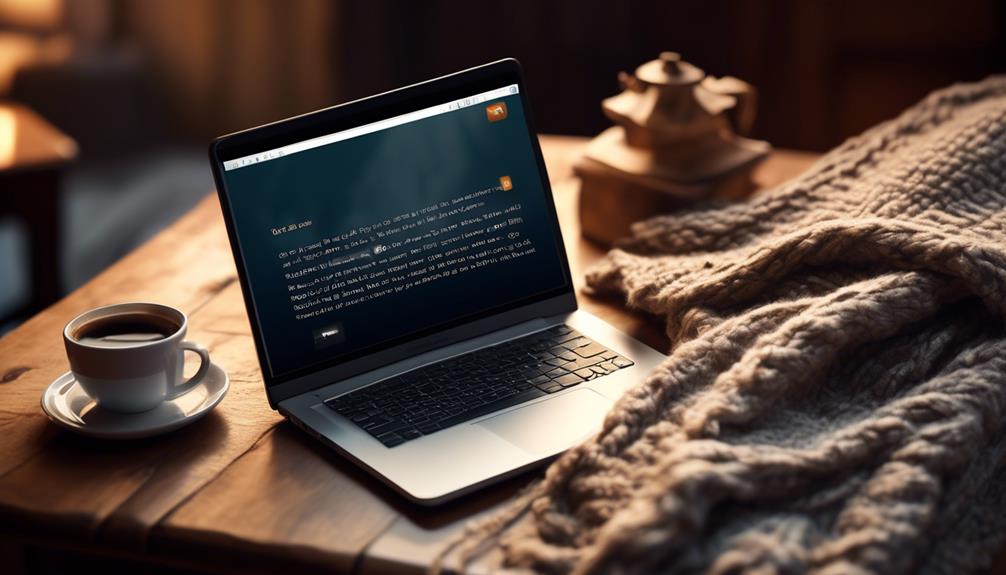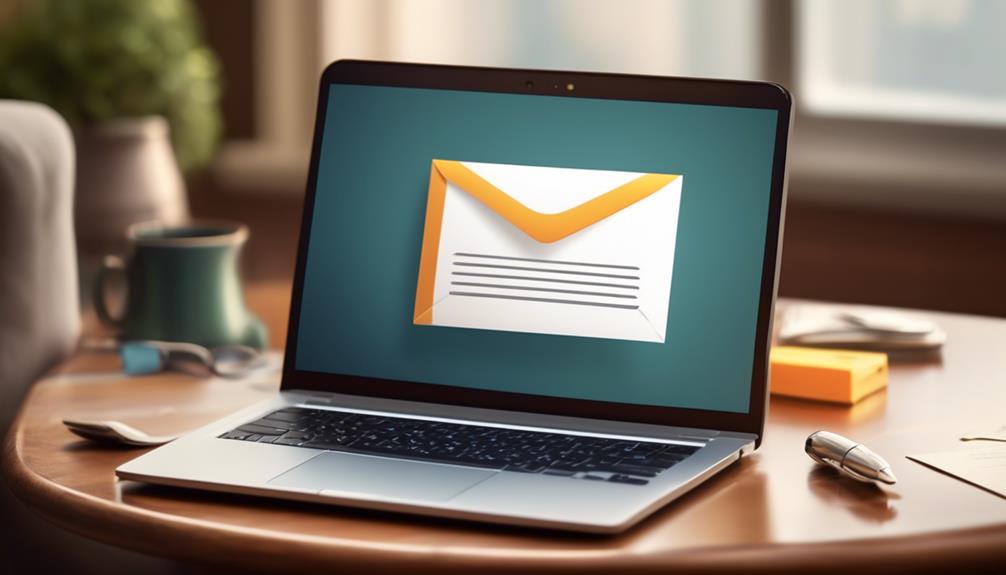In the sphere of professional communication, it is often stated that ‘patience is a virtue.’ When composing a follow-up email with a congenial tone, finding the right balance between persistence and courteousness is crucial.
A well-crafted follow-up message can make all the difference in maintaining a positive connection with your recipient. But what exactly does it take to create an effective follow-up email that leaves a lasting impression?
Let's explore how the art of warm follow-up emails can enhance your communication strategy and help you achieve your desired outcomes.
Key Takeaways
- Personalized follow-up emails nurture relationships and drive successful outcomes.
- Attention to detail and genuine interest are key in crafting personalized follow-up messages.
- Tailor each email to resonate with the prospect's needs and challenges.
- Utilize email marketing software to craft customized follow-up sequences.
Importance of Warm Follow-Up Emails
Understanding the pivotal role warm follow-up emails play in nurturing relationships and driving successful outcomes is crucial in today's competitive business landscape. When we follow up with prospective clients, we've a prime opportunity to demonstrate our genuine interest in their needs, showcase our attentiveness, and provide value tailored to their specific situation.
By personalizing each follow-up email with the prospect's name and referencing past interactions, we show that we value the relationship and are committed to understanding their unique challenges. It's essential to craft follow-up emails that not only address the prospect by name but also speak directly to their industry or role, demonstrating relevance and a deep understanding of their world.
In our sales follow-up emails, we must go beyond generic templates and instead focus on creating compelling content that resonates with the prospective customer. By mentioning specific pain points or challenges discussed previously, we show that we've been actively listening and are ready to provide solutions. This personalized approach helps to build rapport, spark positive connections, and ultimately move prospects through the sales pipeline towards successful outcomes.
Crafting a Personalized Follow-Up Message

As we aim to strengthen our connections with prospective clients, our focus now shifts towards mastering the art of crafting a personalized follow-up message that resonates and drives meaningful engagement. Crafting a personalized follow-up message involves attention to detail and a genuine interest in the recipient. By using the recipient's name and referring to previous interactions, you show that you value the relationship. Keep your message concise, clearly stating the purpose and what you hope to achieve. A compelling subject line increases the chances of your email being opened. Be persistent yet respectful in your follow-up efforts, avoiding common mistakes like being overly sales-y. Personalize each follow-up with specific details about the prospect, such as their name, company, or role. Show genuine interest in connecting with the individual and their unique needs to build rapport effectively.
| Follow-Up Email Templates | Sales Follow-Up Email Templates |
|---|---|
| Personalized Greeting | Clear Call to Action |
| Follow-Up Email Subject Lines | Follow-Up Email Samples |
Strategies for Effective Follow-Ups
To enhance our follow-up strategies, we focus on tailoring each email to resonate with the prospect's specific needs and challenges. By personalizing our communication, we ensure that our messages are relevant and engaging.
Utilizing email marketing software, we can craft customized follow-up email sequences that address the prospect's pain points and offer tailored solutions. This personalized approach not only shows our sincere interest in connecting with the individual but also increases the likelihood of a positive response.
We understand that mentioning the prospect's name, company, or role in the email helps create a personalized touch that fosters a connection. Moreover, by avoiding common mistakes such as bombarding inboxes with repeated emails or being overly sales-y, we can improve our response rates and open rates.
Our goal is to build rapport with prospects by demonstrating that we've carefully considered their unique needs and are committed to providing valuable solutions.
Examples of Warm Follow-Up Emails

In crafting warm follow-up emails, we aim to create meaningful connections by personalizing our messages to align with the prospect's specific needs and interests. When sending personalized follow-up emails, it's crucial to mention the prospect's name and reference previous interactions.
Tailoring the content to their industry or role shows attentiveness. For example, mentioning specific pain points or challenges they've shared can demonstrate understanding. Including relevant case studies or success stories that resonate with their needs can further strengthen the connection.
It's also beneficial to offer a personalized solution or recommendation based on their unique situation. By incorporating these elements, we can effectively follow up with leads, schedule a meeting, or even a quick chat to close deals and boost sales.
A gentle reminder or a suggestion to schedule a call can be the nudge needed to move the conversation forward and drive real results.
Tips for Successful Follow-Up Communication
With a focus on building genuine connections and understanding the prospect's needs, our follow-up communication aims to strengthen relationships and drive positive outcomes.
When crafting follow-up emails, it's crucial to personalize the content by using the recipient's name and referencing previous interactions to make the email more engaging. Tailoring the email to address the prospect's specific needs and pain points can significantly increase its effectiveness.
Additionally, mentioning shared connections or common interests helps establish rapport and build a connection with the recipient. By showing attentiveness to details discussed in prior conversations, you demonstrate sincere interest and care.
Avoid common mistakes like bombarding inboxes with repeated emails or being overly sales-y. Instead, let courtesy, consideration, and compelling content guide your follow-up communication.
Strategic follow-up emails can help re-engage potential clients or leads effectively. Utilize third-party tools like Saleshandy to automate follow-up emails for efficiency and consistency.
Let these tips guide you in creating successful follow-up communication that resonates with your recipients.
Frequently Asked Questions
How Do You Politely Send a Follow up Email?
When sending a follow-up email, we aim to strike a balance between being polite and assertive. It's essential to remind the recipient of our previous communication and express genuine interest in further discussion. Using the recipient's name and referencing specific details can create a personalized touch.
Keep the tone professional yet friendly, and avoid coming across as pushy. Overall, the key is to show courtesy and enthusiasm while respecting the recipient's time and boundaries.
How Do You Say Gentle Follow up in an Email?
We've all been there, wondering how to delicately nudge someone in an email. It's all about striking that perfect balance between being persistent and respectful.
A gentle follow-up email is like a gentle reminder, nudging without overwhelming. It shows interest without being pushy.
Keeping it polite and concise while offering value is key. Remember, a little courtesy can go a long way in fostering relationships through follow-up emails.
How Do You Send a Follow up Email After No Response Sample?
When we send a follow-up email after receiving no response, it's crucial to keep it personalized and tailored to the recipient's needs. Mentioning previous interactions, using their name, and offering specific solutions can help show genuine interest.
Avoid bombarding their inbox with repeated messages and steer clear of being overly sales-y. Crafting a follow-up that demonstrates thoughtful consideration for their industry or role can increase the chances of a response.
How Do You Politely Bump an Email?
When we need to politely bump an email, a gentle reminder can be effective. We may mention the email's subject line or key points briefly and express our continued interest in connecting.
It's crucial to maintain a respectful tone and offer additional information or assistance to encourage a response.
Keeping the follow-up concise and focused on adding value increases the likelihood of a reply without being pushy.
Conclusion
In conclusion, sending warm follow-up emails is crucial for maintaining connections and moving conversations forward.
Did you know that 80% of sales require 5 follow-up emails after the initial contact?
By crafting personalized messages and showing genuine interest, you can increase your chances of receiving a response and ultimately achieving your goals.
Remember to be friendly, helpful, and persistent in your follow-up communication.










